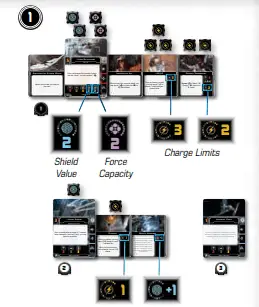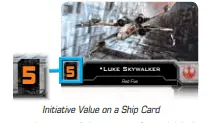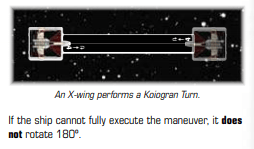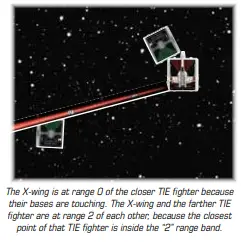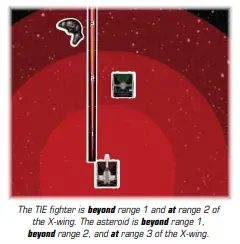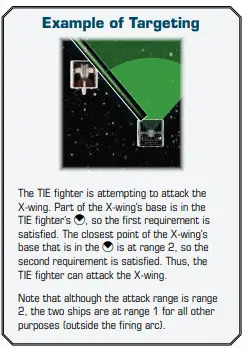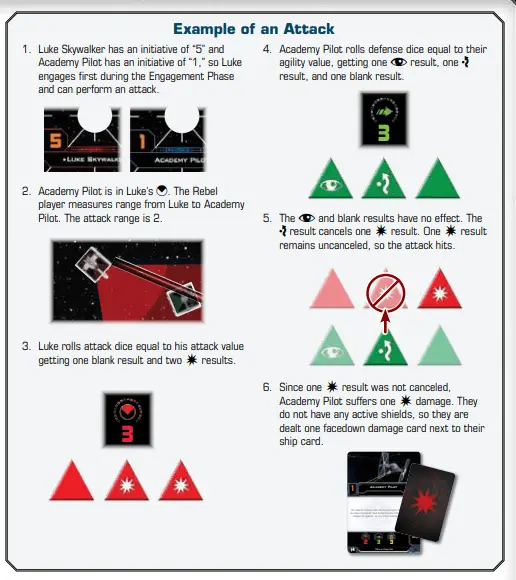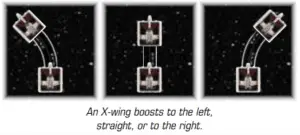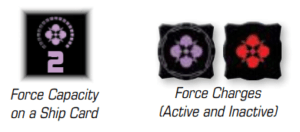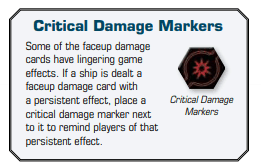Game Summary, Video How to Plays, Reviews
Find out about X-Wing
Quick and Easy to Read Guide on X Wing Miniatures 2.0 rules
Get our guide on X-Wing Miniatures rules and gameplay
We cover the essential instructions and gameplay to help you get through the X Wing Miniatures rule book quickly.
X Wing Miniatures 2nd Edition is a:
- 2 player game where each one controls a squadron of Star Wars starfighters and engage in tactical space combat
- Recommended fo ages 14 and up
Players: 2 to 2 | Game duration from: 30 mins | Game Complexity: EASY How to play Star Wars: X-Wing (Second Edition) rules in simple steps Star Wars: X-Wing (Second Edition) rules pdf / rulebook [amazon box=”B07CSC5NGH”]
What is the goal?
You control a squadron of Star Wars star fighters and battle against your opponent
Destroy your opponent\’s starfighters by engaging a tactical space combat
Game setup
Squad Building – Choosing and upgrading your ships
Each player chooses ship and upgrade cards
Quick Build X Wing Miniatures Game Mode
- players create a squad quickly using predefined selections
- Each ship comes with Quick Build cards that list different options for that ship
- Each option consists of a ship card, a number of upgrade cards, and a threat level (a number of bars 1–5). Threat level represents the strength of that particular combination of pilot and upgrade cards
- To play a match, players choose a particular threat level
- For a normal game on a 3’x3’ (91 cm) play area, play at threat level eight. You will need more ships than those included in the core set to play at this threat level
- Players build squad by choosing a combo of Quick Build options that add up to the threat level
Squad Points X Wing Miniatures Game Mode
- Players get full control of pilots and upgrades and build squads using SQUAD POINTS
- players must download the official X-Wing squad-builder on their mobile device or access the squad-builder via X-Wing.com
- The X-Wing squad-builder explains the rules of squad-point building and enforces these rule
Limited Cards
- Some cards are limited and identified by one or more bullets to the left of their name
- The squadron cannot have more copies of a card that share the same name than the number of bullets
UPGRADE CARDS: Upgrade your ships
- Upgrade cards represent the different ways pilots customize their ships and provide special abilities or alternative ways to attack.
- Upgrade cards are equipped before a game starts.
- When a ship equips an upgrade card, it is placed partially beneath the ship card or another equipped upgrade so that only the text and art on the upgrade card are visible.
Limited Cards
- Some cards are limited and identified by one or more bullets to the left of their name
- The squadron cannot have more copies of a card that share the same name than the number of bullets
UPGRADE CARDS: Upgrade your ships
- Upgrade cards represent the different ways pilots customize their ships and provide special abilities or alternative ways to attack.
- Upgrade cards are equipped before a game starts.
- When a ship equips an upgrade card, it is placed partially beneath the ship card or another equipped upgrade so that only the text and art on the upgrade card are visible.
Special Weapons
Upgrade cards with the “Attack:” header, such as Proton Torpedoes, are special weapons. A ship can perform an attack with a special weapon instead of using its primary weapon.
Special weapons have the following characteristics:
- Arc Requirement: This indicates the arc this weapon attacks from. The target must be in this
arc for the weapon to be used. - Attack Value: This is the number of attack dice the attacker rolls.
- Range Requirements: The attack range must match one of the ranges listed for the weapon to be used.
- Range Bonus Indicator: If there is a missile symbol present, range bonuses are not applied while attacking with this weapon.
- If there is a symbol in parentheses in the header, that symbol indicates an additional attack requirement.
This means that the attacking ship needs to have performed that action.

Charges
-
- Many upgrade cards have a limited amount of uses. These cards hold standard charges
 and limits how often it is used.
and limits how often it is used. - Each card with a charge limit (the golden number) starts the game with a number of
 equal to the charge limit. Each
equal to the charge limit. Each  starts on its active side
starts on its active side - Card’s ability instructs how and when to spend
 from that card. When spent the
from that card. When spent the  is flipped to the inactive side.
is flipped to the inactive side.
During End Phase, each card with a charge limit recovers 1
 if it has a recovery arrow next to it. Flip
if it has a recovery arrow next to it. Flip  to its active side.
to its active side. - Many upgrade cards have a limited amount of uses. These cards hold standard charges
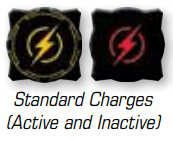
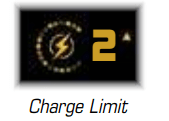
Setup of Game
Once squad building is completed, complete the following steps:
-
Gather Forces
- Place your ships and upgrade cards in front
- For ships with shield value, charge limit or force capacity, put corresponding shields or charges above the ships and upgrade cards
- Assign ID tokens to ships


Gameplay
X-Wing Miniatures is played over a series of rounds. Each round has 5 phases:
- Planning Phase: Choose maneuvers for your ship using the maneuver dials
- System Phase: Some ships complete specific abilities
- Activation Phase: Move and perform ship actions
- Engagement Phase: Each of your ships may attack
- End Phase: Remove circular tokens from ships and some charges recover. After each End Phase, start a new round until one player has no ships remaining.
1. Planning Phase
- Each player secretly sets a maneuver for each of their ships, using the maneuver dial. Each ship type has a different dial that reflects its unique capabilities
- A maneuver indicates the ship\’s movement and comprises three components:
- speed (the number),
- bearing (the arrow),
- difficulty (the colour)
- Speed and bearing indicate the distance and angle of the maneuver. Each maneuver follows a template that shows the same speed and bearing
- When setting a ship\’s maneuver, you take a dial corresponding to that ship and rotate it until the arrow points to your maneuver choice. You assign the dial to its corresponding ship by placing it facedown next to the ship
- Once all ships have dials assigned, proceeds to the System Phase.


2. System Phase
- Some ships have special abilities that resolved during the System Phase
- Abilities are resolved according to initiative order, starting with the lowest
- X-Wing core set ships do not have these abilities, but some expansion ships do

INITIATIVE
- Ships have an initiative value on their ship card and tokenThe Initiative represents the pilot’s reflexes, skill, or even luck
- The primary function of Initiative is to determine the order in which ships act
- If a player has two or more ships with the same Initiative, that player decides the order
- If both players have ships with the same Initiative, those ships act in player order.
- The player who receives the first player marker during setup is the first player; their ships of that initiative act first. Then the other player’s ships of that initiative act.

3. Activation Phase
Maneuver your ships
Each ship activates one at a time based on initiative order, starting with the lowest. When a ship activates, complete the following:
- Reveal Dial: The ship’s assigned maneuver dial is flipped faceup and placed next to its ship card
- Execute Maneuver: Ship executes the maneuver selected on the dial. When executing a maneuver, follows these steps:
- Take the template that matches the maneuver
- Set the template between the ship’s front guides so that it is flush against the base
- Pick up and place the ship at the opposite end of the template. Slide rear guides of the ship into the template. Return the template
- After moving, check the maneuver difficulty (colour). If red, the ship gains one stress token. If blue, ship removes one stress token.
- Stress Token: A ship is stressed when it has one or more stress tokens. Once a ship gains a token (such as a stress token), it is placed next to it. Tokens follow the ship as it moves. Stressed ships cannot:
- set or execute red maneuvers,
- cannot perform actions
- Perform Action: The ship may perform one action. Choosing and performing actions are some of the most impactful decisions during the game. Actions primarily provide the ability to reposition, enhance offensive or defensive capability during the Engagement Phase. Actions are explained in the Additional Rules section
Once every ship has activated, proceed to the Engagement Phase.

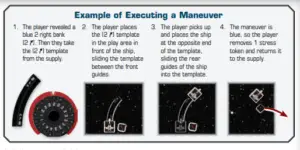
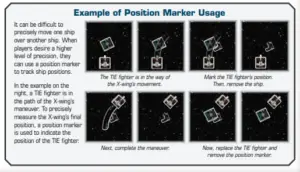
Partial Maneuvers
Ships fully execute maneuvers when nothing prevents the ship from being placed at the end of the template.
Even when moving through another ship, which means the template is placed on top of that ship, the ship still fully executes the maneuver.
A ship executes a PARTIAL MANEUVER when it is unable to be placed at the end of the template because it overlaps another
ship. This causes it to moves a shorter distance.
Partial maneuver involves the following steps:
- Move the ship backward along the template until its base is no longer overlapping another ship’s base. While doing so, adjust the position of the ship so that the hash marks in the middle of both sets of guides remain centred over the line
down the middle of the template. - Once the ship is no longer on top of any other ship, place it so that it is touching the last ship it backed over. This may result in the ship not leaving its initial position.
- The ship skips its Perform Action step. Ships attack at range 1–3, which means a ship cannot attack a ship that it is touching because that ship is at range 0.
Advanced Maneuvers
How do you win?
Destroy the all the ships of your opponent
